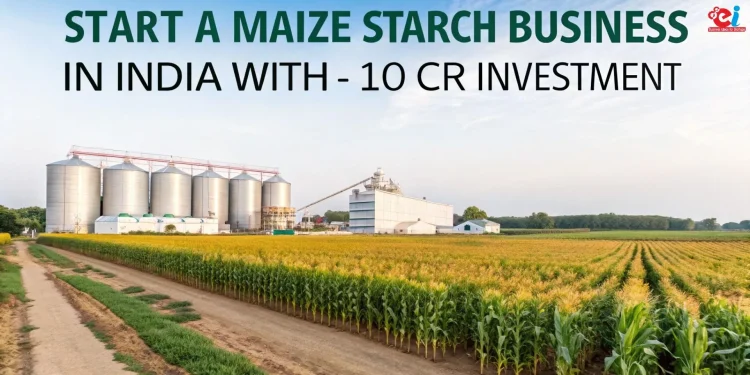Few ingredients are more useful than maize starch in the vast domain of industrial manufacturing and processing. Sourced from the endosperm of corn kernels, maize starch, or corn starch, is of primal importance in a multitude of industries, functioning as a thickener, binder, filler, and stabilizer. If you are having custard, taking a tablet, wearing a printed shirt, or using a glossy sheet of paper, it is highly likely that maize starch has invisibly, yet decisively, aided in the creation of the product at hand.
With India being one of the leading global producers of maize, the country is witnessing a marked increase in the demand for maize starch due to its downstream applications expanding in food processing, pharmaceuticals, textiles, adhesives, paper, and even biodegradable packaging. Maize starch is increasingly proving to be more than just a cheap filler, as the global shift towards natural, biodegradable, and plant-based alternatives mark it as a strategic raw material for sustainable manufacturing.
Here, we break down why maize starch is an economically relevant under acknowledged industrial ingredient, and why entrepreneurs, manufacturers, and investors need to focus their attention.
What Is Maize Starch and How Is It Produced?
Maize starch is a polymer, primarily composed of amylose and amylopectin, distinguished by their glucose chains which provide it with the capability to thicken and gel. The slurry is separated into starch, gluten, fiber, and germ, after which the thoroughly soaked corn kernels are ground and undergo wet milling.
Starch is extracted from corn through a soaking, grinding, and milling process. The end product is a white powder lacking in odor and flavor. Depending on the industry, maize starch can be in its native form or be subject to further modification into dextrin, glucose syrup, maltodextrin, high fructose corn syrup (HFCS), or modified starches, each with its own functional benefits in specialized industrial applications.
Maize Starch in the Food and Beverages Industry
More commonly known as corn starch, maize starch is an integral ingredient in foods. Corn starch has the ability to not only aid in thickening but also stabilizing and adding body to an array of foods, ensuring proper texture and consistency in dairy desserts, confections, soups, sauces, and even gravies. Additionally, its mild taste renders it acceptable for use in sweet and savory dishes.
In the food processing industry, maize starch is used in baking, snacks, instant noodles, and breakfast cereals as a bulking and binding agent. It has become very critical in calorie management by adding bulk in low calorie items without fat and improving mouthfeel in low calorie foods.
Maize starch derivatives like maltodextrin are increasingly used in beverage processing to enhance solubility and energy density in sports drinks and dietary supplements. For canned and processed foods that are subjected to multiple heating cycles, modified starches that have heat and acid resistance are critical.
In dry mix products, uniform distribution of additives is essential and maize starch derivatives help achieve constant distribution of flavors, colors, and vitamins.
Related: Adhesive from Maize Starch
Healthcare and Pharmaceutical Applications
In formulating and processing, the healthcare and pharmaceutical sectors rely heavily on maize starch. During tablet production, maize starch is a binder, filler, and disintegrant. It is important in maintaining the structural framework in a tablet during the entire life cycle of the product until used to ensure it crumbles easily during intake for effective dosage release.
Maize starch is now utilized in making powder, syrup, and capsule shells. The fact of being nontoxic and easily digestible makes a good excipient during drug formulation. It also plays an important part in tablet coating as it helps control drug release and gives an elegant smooth finish.
There is an increasing use of controlled release dosage forms with modified starches where the timing and precision of release and dosage is vital. In the case of nonprescription dietary supplements and functional food, there is developed unexplored potential in maize starch for formulations that are health focused, frequently used as supports for vitamin or minerals tablets and powders.
Critical Role in the Textile Industry
Maize starch is very important in controls the weaving process of textiles. It acts as a sizing agent for yarns, increases their strength, reduces their breakage, improves the efficiency of weaving and thus saves labor. Starch is applied to cotton or synthetic fibers, it acts as a protective coating on the yarn itself, thus enabling it to withstand the mechanical abrasion of looms.
Starch that is obtained from maize also helps in smoothing of fabrics and improving printability for textiles. Starch pastes play an important part in firmly attaching pigments and dyes to fabric surfaces, thus, improving adherence to color and brightness.
After weaving or printing the fabric, removal of starch during desizing does not damage or leave any marks which makes it helpful in industries where color richness and fabric integrity matter.
Maize starch has a non-toxic, natural profile that makes it an appropriate substitute for synthetic sizing agents, especially when the textile industry is shifting towards eco-friendly and biodegradable chemicals.
Applications in the Paper and Packaging Industry
Starch is used for several steps in the production of paper. It acts as a binder which offers additional strength to the paper while providing oil and water resistance. Sizing also helps to improve smoothness and provides better ink adherence, which is essential when printing and packaging.
In the production of corrugated boxes, starch-based adhesives are utilized to fix the linerboards and flutes. The adhesives provide excellent tack and fast set rates so the energy needed is reduced and process becomes more efficient.
As paper is being recycled, maize starch acts as a binder with paper pulp. The held Tahitiens strength is improved whereas paper brittleness is decreased with this. Starch is being used nowadays in films and coatings for packaging materials, especially biodegradable and eco-friendly packaging materials, making it helpful with the switch towards recyclable materials.
Bioplastics derived from maize starch are becoming increasingly prevalent as single-use plastic bans become more common around the world.
Related: Technical and Economic Evaluation of Maize Starch Production
Other Emerging Applications of Maize Starch
Maize starch is now being utilized in more advanced and emerging fields. It is used as a feedstock for ethanol production in the biofuel industry. The starch is first fermented into glucose, then bioethanol—a cleaner alternative to fossil fuels—is produced from it.
In the cosmetic industry, it is included in skin care formulations, dry shampoos, and even talcum powders. This is due to its soft texture as well as moisture absorbing properties. Moreover, it is found in biodegradable personal care products and nonwashable detergents that consumers who want plant and allergen-free options prefer.
Maize starch and its derivatives are also used in agriculture and animal feed in the form of binders for pelletized feeds, seed coatings, and as part of agricultural sprays.
The versatility of maize starch can be seen in construction as well. It is being experimented with in the form of wall putty and plasters, as well as insulation materials.
Analysis and Insights on the Market and Areas for Investment
With an estimated value of over USD 30 billion in 2022, the global maize starch market is projected to grow at a rate of over 5% CAGR through 2030. Domestically, the market is buoyant due to agricultural production, growing downstream industries, and an increasing emphasis on agro processing.
Maize producing states like Karnataka, Maharashtra, Andhra Pradesh, and Bihar are also favorable for starch processing units. Installing a maize starch plant includes wet milling, centrifuges, dryers, and silos which can cost from ₹10 crore to ₹30 crore for medium scale plants depending on capacity and level of automation.
Provisions under the PMFME scheme, Agri-Infra Fund and cluster development of MSME support the financial aid and grants for starch-based agro processing units. There are also favorable prospects for exports to the Middle East, South East Asia, and even Africa which adds to the business potential.
As demand for starch derived bioplastics and other natural industrial materials increases, businesses involving maize starch are being viewed as environmentally friendly and resilient while also being highly sustainable and profitable.
Conclusion: Maize Starch—A Silent Champion in Industrial Evolution
Often hidden in the background, maize starch is the quiet workhorse behind hundreds of everyday products and industrial processes. Its ability to adapt across food, pharmaceutical, textile, paper, packaging, and emerging green industries underscores its irreplaceable value.
As global industries move toward clean-label ingredients, renewable resources, and sustainable manufacturing, maize starch is set to play a more prominent role in the supply chain. For entrepreneurs, agribusiness investors, and food processors, this natural polymer represents a unique opportunity to align profitability with sustainability.
Whether you’re exploring new product lines or backward integration into agro-processing, maize starch is no longer just a commodity—it’s a cornerstone of the green industrial revolution.
Let Niir Project Consultancy Services (NPCS) guide you with a comprehensive DPR, technical feasibility report, and market analysis tailored to your maize starch venture.


























